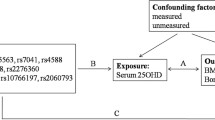Abstract
Summary
LCT 13910 CC genotype is associated with lactose intolerance, a condition often resulting in reduced milk intake. Women with the CC genotype were found to have decreased serum calcium and reduced bone mineral density.
Introduction
The CC genotype of the 13910 C/T polymorphism of the LCT gene is linked to lactose intolerance and low calcium intake.
Methods
We studied 595 postmenopausal women, including 267 osteoporotic, 200 osteopenic, and 128 healthy subjects. Genotyping, osteodensitometry, and laboratory measurements were carried out.
Results
Frequency of aversion to milk consumption was 20% for CC genotype and 10% for TT + TC genotypes (p = 0.03). The albumin-adjusted serum calcium was 2.325 ± 0.09 mmol/L for CC genotype and 2.360 ± 0.16 mmol/L for TT + TC genotypes (p = 0.031). Bone mineral density (BMD; Z score) was lower in the CC than TT + TC genotypes, respectively, at the radius (0.105 ± 1.42 vs 0.406 ± 1.32; p = 0.038), at the total hip (−0.471 ± 1.08 vs −0.170 ± 1.09; p = 0.041), and at the Ward’s triangle (−0.334 ± 0.87 vs −0.123 ± 0.82; p = 0.044).
Conclusion
LCT 13910 C/T polymorphism is associated with decreased serum calcium level and lower BMD in postmenopausal women.

Similar content being viewed by others
References
Sahi T, Isokoski M, Jussila J et al (1973) Recessive inheritance of adult-type lactose malabsorption. Lancet 2:823–826
Obermayer-Pietsch BM, Bonelli CM, Walter DE et al (2004) Genetic predisposition for adult lactose intolerance and relation to diet, bone density, and bone fractures. J Bone Miner Res 19:42–47
de Vrese M, Stegelmann A, Richter B et al (2001) Probiotics—compensation for lactase insufficiency. Am J Clin Nutr 73:S421–S429
Carroccio A, Montalto G, Cavera G et al (1998) Lactose intolerance and self-reported milk intolerance: relationship with lactose maldigestion and nutrient intake. Lactase Deficiency Study Group. J Am Coll Nutr 17:631–636
Obermayer-Pietsch BM, Gugatschka M, Reitter S et al (2007) Adult-type hypolactasia and calcium availability: decreased calcium intake or impaired calcium absorption? Osteoporos Int 18:445–451
Sahi T (1994) Genetics and epidemiology of adult-type hypolactasia. Scand J Gastroenterol Suppl 202:S7–S20
Vesa TH, Marteau P, Korpela R (2000) Lactose intolerance. J Am Coll Nutr 19:S165–S175
Tang BM, Eslick GD, Nowson C et al (2007) Use of calcium or calcium in combination with vitamin D supplementation to prevent fractures and bone loss in people aged 50 years and older: a meta-analysis. Lancet 370:657–666
Enattah NS, Sahi T, Savilahti E et al (2002) Identification of a variant associated with adult-type hypolactasia. Nat Genet 30:233–237
Enattah N, Pekkarinen T, Valimaki MJ et al (2005) Genetically defined adult-type hypolactasia and self-reported lactose intolerance as risk factors of osteoporosis in Finnish postmenopausal women. Eur J Clin Nutr 59:1105–1111
Gugatschka M, Hoeller A, Fahrleitner-Pammer A et al (2007) Calcium supply, bone mineral density and genetically defined lactose maldigestion in a cohort of elderly men. J Endocrinol Invest 30:46–51
Enattah N, Valimaki VV, Valimaki MJ et al (2004) Molecularly defined lactose malabsorption, peak bone mass and bone turnover rate in young Finnish men. Calcif Tissue Int 75:488–493
Honkanen R, Kroger H, Alhava E et al (1997) Lactose intolerance associated with fractures of weight-bearing bones in Finnish women aged 38–57 years. Bone 21:473–477
Vigorita VJ, Lane M, Suda MK et al (1987) Differences between lactase deficient and non-lactase deficient women with spinal osteoporosis. Clin Orthop Relat Res 215:248–253
Livak KJ (1999) Allelic discrimination using fluorogenic probes and the 5′ nuclease assay. Genet Anal 14:143–149
Harvey CB, Wang Y, Darmoul D et al (1996) Characterisation of a human homologue of a yeast cell division cycle gene, MCM6, located adjacent to the 5′ end of the lactase gene on chromosome 2q21. FEBS Lett 398:135–140
Park J, Hwang S, Lee YS et al (2007) SNP@Ethnos: a database of ethnically variant single-nucleotide polymorphisms. Nucleic Acids Res 35:711–715
Kuokkanen M, Enattah NS, Oksanen A et al (2003) Transcriptional regulation of the lactase-phlorizin hydrolase gene by polymorphisms associated with adult-type hypolactasia. Gut 52:647–652
Troelsen JT, Olsen J, Moller J et al (2003) An upstream polymorphism associated with lactase persistence has increased enhancer activity. Gastroenterology 125:1686–1694
Buning C, Genschel J, Jurga J et al (2005) Introducing genetic testing for adult-type hypolactasia. Digestion 71:245–250
Cadogan J, Eastell R, Jones N et al (1997) Milk intake and bone mineral acquisition in adolescent girls: randomised, controlled intervention trial. BMJ 315:1255–1260
Norat T, Dossus L, Rinaldi S et al (2007) Diet, serum insulin-like growth factor-I and IGF-binding protein-3 in European women. Eur J Clin Nutr 61:91–98
Di Stefano M, Veneto G, Malservisi S et al (2002) Lactose malabsorption and intolerance and peak bone mass. Gastroenterology 122:1793–1799
Dahlgren A, Lundmark P, Axelsson T et al (2008) Association of the estrogen receptor 1 (ESR1) gene with body height in adult males from two Swedish population cohorts. PLoS ONE 3:1807
Ruza E, Sotillo E, Sierrasesumaga L et al (2003) Analysis of polymorphisms of the vitamin D receptor, estrogen receptor, and collagen Ialpha1 genes and their relationship with height in children with bone cancer. J Pediatr Hematol Oncol 25:780–786
Gugatschka M, Dobnig H, Fahrleitner-Pammer A et al (2005) Molecularly-defined lactose malabsorption, milk consumption and anthropometric differences in adult males. Qjm 98:857–863
Acknowledgements
This work was supported by grants from NKFP-1A/002/2004 and NKFP-1A/007/2004 and by grant from Semmelweis University. Special thanks to Pal Czobor for his help in statistical analyses.
Conflicts of interest
None.
Author information
Authors and Affiliations
Corresponding author
Additional information
Péter Lakatos and Gábor Speer contributed equally to this work.
Rights and permissions
About this article
Cite this article
Bácsi, K., Kósa, J.P., Lazáry, Á. et al. LCT 13910 C/T polymorphism, serum calcium, and bone mineral density in postmenopausal women. Osteoporos Int 20, 639–645 (2009). https://doi.org/10.1007/s00198-008-0709-9
Received:
Accepted:
Published:
Issue Date:
DOI: https://doi.org/10.1007/s00198-008-0709-9




